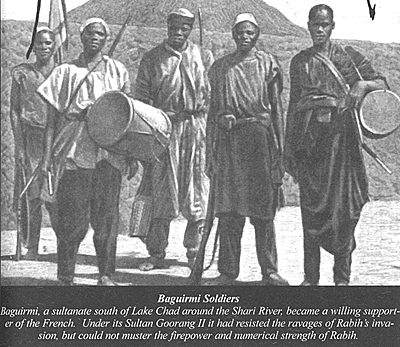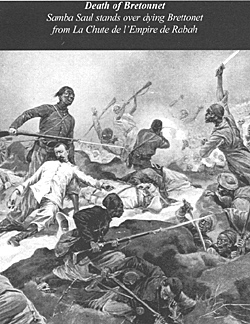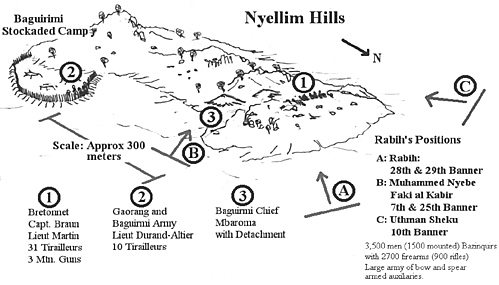 Central Sudan, 1874 – 1911
Central Sudan, 1874 – 1911
Henri Bretonnet was an adventurer, an explorer and a soldier. In July 1899, he and his small force were the vanguard reconnaissance for the military expedition of Emile Gentil. Gentil was navigating his steamer, the Léon Blot, down the Shari River towards Lake Chad in Central Africa. He had steamed from Brazzaville up the River Congo and then its tributary the Ubangi. After dismantling the boat, it was manhandled across the watershed to the Shari River that fed eventually into Lake Chad.
Lake Chad was a supposed rendezvous point of three great missions across Africa into the interior. This was France’s part in the Europeans’ land grab known as the Great Scramble. The Forreau-Lamy mission was to cross the Algerian Sahara and approach from the north. The Voulet Chanoine Mission was to move eastwards from Senegal across the vast expanses of the upper Niger.
Bretonnet had entered the Sultanate of Bagirmi whose exiled Sultan Gaorang II had allied himself to the French mission. Bagirmi had been invaded and conquered by a great warlord and slaver Rabih Fadl Allah. Rabih was aware of the coming French mission and saw it as a threat to his power base.
Bretonnet advanced as far as Kuno, a Bagirmian town on the banks of the Shari, and was informed of Rabih’s approaching army. He was concerned that his small force would not be able to defend Kuno so he had pulled back south 15 kilometers to rocky high ground that rose out of the otherwise flat featureless terrain. Bretonnet’s reconnaissance had accurately gauged the strength of Rabih’s slave army at 13,000 warriors but was confident in letters dispatched prior to the impending battle that he would be able to hold out.
The Battle of Nyellim Hills
Bretonnet prepared a defensive position near the summit of one of the several small rocky outcrops known as the Nyellim hills. He was less than 500 kilometers south of Lake Chad, in territory technically ceded to Germany at the Berlin Conference. Two kilometers west of the Shari River, such cartographic declarations had little meaning as no Germans were here. His force consisted of four officers, three mountain guns and 44 Senegalese and Congolese tirailleurs. He was also supported by 500 troops of the Bagirmian Army under direct command of Sultan Gaorang.
A master of defensive actions, Rabih was going on the offensive and advanced to Nyellim hills with 13 of his 29 companies known as “Banners”. These quasi-regular formations were the core of his army and were supported by 10,000 auxiliaries armed with spear and bow. Of the 29 banner companies whose troops were termed bazingers, some 2,700 were armed. About 900 of these had breach loading rifles, mostly Remingtons, the rest a mix of flintlock smooth bore and percussion rifled muskets. A further 1,500 of the bazingers were mounted.
Nyellim hills consist of two principal summits north and south of each other with a narrow defile separating the two. Gaorang’s camp was built at the eastern base of the rear (southerly) summit, and Bretonnet’s defensive position was formed at the north end of the forward summit.
Lieutenant Durand-Autier was positioned in the camp with one of the mountain guns and 10 tirailleurs along with the bulk of the Bagirmi force. Bretonnet, Lieutenant Braun and maréchal de logis Martin (quartermaster sergeant) with 30 of the tirailleurs positioned themselves on the forward (northerly) summit with a view of the plain over which Rabih must advance. Gaorang detached a group under the captain M’baroma to defend the defile to prevent Rabih’s forces from sweeping around the flank and gaining a fire position overlooking the main French position.
At 8:00 am on the morning of July 17, 1899, the attack began. Rabih’s mounted troops lead the attack, but eight salvos from the mountain guns quickly broke their assault. Regrouping for a second assault, Rabih dismounted his horse and divided into three attack groups. His banner leader Muhammad Nyebe and Faki al Kabir would lead the 7th and 25th banners in a flanking maneuver around the main position and assault the defile. Uthman Sheku was to lead the 10th banner in an attempt to split the fire and advance up the hill on Bretonnet’s left flank, while Rabih with his two elite Body Guard banners, the 28th and 29th would assault the main position.
Once the assaults reached the base of the hills, there was good cover to be found and the attacks were able to pour fire back into the French positions. In the first assault from Uthman Sheku, Braun was killed and Bretonnet was shot in the chest. He was propped up on an ammunition chest and leaned against a rock where he continued to direct fire.
Muhammad Nyebe’s assault pushed towards the defile and the auxiliaries peeled off to storm the stockade. As his situation was deteriorating, Bretonnet wrote a message to have Durand-Autier make his way to Bretonnet’s main position with the other 10 tirailleurs and the mountain gun.
While writing his message another assault under Uthman Sheku was driven off, however, the flanking maneuver under Muhammad Nyebe and Faki Ahmad broke the position of M’baroma and gained the high ground behind Bretonnet’s position and was able to pour fire a fierce down onto the main position. Durand-Autier had received his message and sallied from the camp in an attempt to force his way to Bretonnet’s position.
Gaorang’s main force began to appreciate the hopelessness of their position and broke out of the camp, barely escaping, Sultan Gaorang receiving two bullet wounds in the arm.
Rabih himself personally directed the final foray onto the peak. By the time his men forced the result against the fierce and heroic defense, only three tirailleurs including Sergeant Sall remained alive. Rabih quickly appreciated the small size of the defending force and was livid that so few men had caused such horrendous casualties to his army. He had lost 63 senior commanders and over 500 of his regular bazingers as well as a huge (unspecified) number of auxiliaries.
Rabih had his interpreter, a former tirailleur (see Crampel mission later) offer Samba Sall a position in his army, so impressed was he by his heroism. Samba Sall rejected the offer, but the interpreter was also overwhelmed by the defenders’ bravery. He sought to save Samba Sall’s life and translated Sall’s response as an ambiguous and non-committal answer. Sall’s life was spared for the time being but the next morning, under the pretext of a call of nature, Sall was able to escape and made his way back to Gentil’s mission.
 Bretonnet received a second wound and died. The tirailleurs, now under the command of Senegalese sergeant Samba Sall continued to defend the position against ever-poorer odds. Durand-Autier never made it to the main position as Muhammad Nyebe and Faki Ahmad’s men cut him down from the high ground.
Bretonnet received a second wound and died. The tirailleurs, now under the command of Senegalese sergeant Samba Sall continued to defend the position against ever-poorer odds. Durand-Autier never made it to the main position as Muhammad Nyebe and Faki Ahmad’s men cut him down from the high ground.

African Warlord: Central Sudan, 1874 – 1911 The Rise and Fall of the Empire of Rabih Fadl Allah
-
Part One: Battle of Nyellim Hills
Part One: A Leader Emerges
Part One: The Years Under Sulaiman
Part One: Azande Warfare
Part One: Jumbo Map of Central Sudan (slow: 116K)
African Warlord: Central Sudan, 1884 – 1911 Part 2
-
Part Two: Rise to Dominance
Part Two: Rabih's Army
Part Two: Organization of the Banners (very slow: 212K)
Part Two: Gentil's Missions 1897-1899
Part Two: Jumbo Color Illustration: Rabih's Warriors (slow: 319K)
Back to Table of Contents -- Courier #87
To Courier List of Issues
To MagWeb Master Magazine List
© Copyright 2003 by The Courier Publishing Company.
This article appears in MagWeb.com (Magazine Web) on the Internet World Wide Web.
Other articles from military history and related magazines are available at http://www.magweb.com